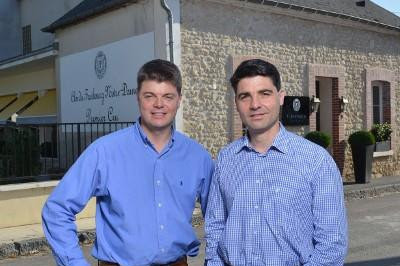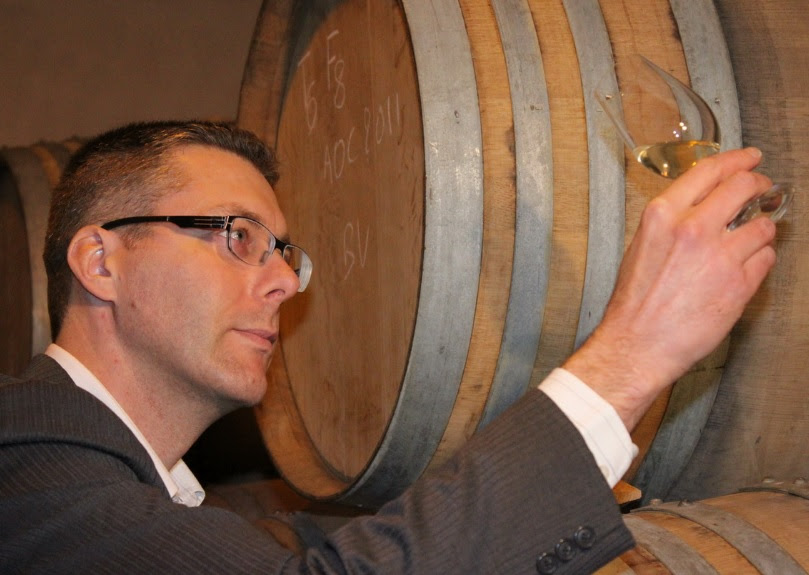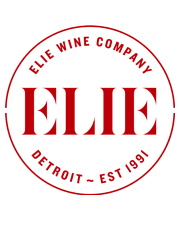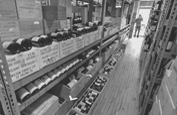First-Rate Producer + Excellent Vintage + Underrated Appellation = Superb Value 2015 Bordeaux
Château La Vieille Cure (Fronsac 2015)
$183/6-pack (~$31/bottle)
The appellation of Fronsac is one of Bordeaux’s lesser known winemaking regions. It is an area of back-country roads and tiny vineyards a stone’s throw from the celebrated appellations of Pomerol and Saint-Émilion. Indeed, Fronsac is five times smaller than Saint-Émilion, with a more homogenous terroir of limestone and clay — “Fronsac molasses” it’s sometimes called by the grape farmers that toil its vineyards. By any name the Merlot grape is natural in these soils. In the right hands, wines made in Fronsac can be as good as many of the wines from its big-name neighbors, without the big-name price tag.
While the vineyards of Château La Vieille Cure were cultivated as far back as the 17th Century, the modern era for the estate begins in the mid-1980s as the property saw a complete renovation, from vineyard to cellar. It took less than a decade after the rebuilding effort for the estate to be recognized among the top producers in the Fronsac appellation.
With 50 acres in one single plot, Château La Vieille Cure appears on a famous map of the Guyenne region, known as the Belleyme map, dated 1780.  These vineyards, planted to 74% Merlot, 22% Cabernet Franc and 4% Cabernet Sauvignon, lie on ideally positioned southeast facing slopes of a plateau at about 200 feet in elevation between the towns of Saillans and Fronsac overlooking the river Isle and the Dordogne. The estate boasts some of the oldest vines in the region.
These vineyards, planted to 74% Merlot, 22% Cabernet Franc and 4% Cabernet Sauvignon, lie on ideally positioned southeast facing slopes of a plateau at about 200 feet in elevation between the towns of Saillans and Fronsac overlooking the river Isle and the Dordogne. The estate boasts some of the oldest vines in the region.
Winemaking at Château La Vieille Cure is overseen by Jean-Luc Thunevin, recognized as a leading figure on the “Right Bank” of Bordeaux from his formation of the Saint-Émilion Premier Grand Cru Classé Château Valandraud.
At harvest, all fruit is hand-picked and hand-sorted. Fermentation takes place in stainless steel vats while aging takes place in French oak barrels, a portion of which are new. The 2015 vintage of Château La Vieille Cure presents itself first with exuberant aromatics of black raspberry, mocha, and cedar plank grilled herbs. On the palate the warm 2015 vintage registers as generous fruit yet the ripeness never becomes tiresome due to an ideal freshness coupled with a vein of minerality that persists through a lengthy finish. At this price you won’t feel bad opening a bottle to pair with burgers or buying a bunch to drink over the course of the next decade.

- - -
Posted on 2018.08.09 in France, Bordeaux, Saturday Sips Wines | Read more...
2015 Second Wine from Château Smith Haut Lafitte, Classified Producer in Pessac-Léognan
Château Smith Haut Lafitte “Le Petit Haut Lafitte” (Pessac-Léognan 2015)
$253/6-pack (~$42/bottle)
From the soils of Pessac-Léognan on the left bank of the Garonne in Northern Graves, Château Smith Haut Lafitte’s history in Bordeaux dates back over 800 years. The estate started as part of the Du Boscq holdings and vines were first planted in the 14th Century on the gravelly Lafitte Plateau. For centuries the terroir was recognized for its superiority and Smith Haut Lafitte was ranked among the Crus Classés for red wine in the Classification of Graves wine of 1953 and 1959.  But it was when Daniel and Florence Cathiard purchased the estate in 1990 that Château Smith Haut Lafitte’s greatest leap in quality began.
But it was when Daniel and Florence Cathiard purchased the estate in 1990 that Château Smith Haut Lafitte’s greatest leap in quality began.
One of the first changes the Cathiards implemented was hand harvesting of the fruit. To avoid damage to the berries and subsequent oxidization, the freshly picked fruit is placed in specially designed carriers developed by Daniel Cathiard based on a design used by Sherpas in the Himalayas. Manual sorting is a major part of the work that takes place at Smith Haut Lafitte. The fruit is sorted two separate times to ensure that only the most desired raw material makes it into the finished wines. All work in the vineyard is organic and self sustainable and many of the farming techniques are biodynamic. In the cellars, all the wine is moved by gravity.
 Second label Bordeaux have always offered incredible value, but as the selection process for the “Grand Vin,” or first wine, has gotten stricter, today the best “seconds” offer an even greater value than in the past. Designed during the blending of the Grand Vin of Smith Haut Lafitte, Le Petit Haut Lafitte is vinified and aged with the same care as the batches that will become the first wine of the Château.
Second label Bordeaux have always offered incredible value, but as the selection process for the “Grand Vin,” or first wine, has gotten stricter, today the best “seconds” offer an even greater value than in the past. Designed during the blending of the Grand Vin of Smith Haut Lafitte, Le Petit Haut Lafitte is vinified and aged with the same care as the batches that will become the first wine of the Château.
The 2015 Le Petit Haut Lafitte is a blend of 60% Cabernet Sauvignon and 40% Merlot. Maturation is carried out in oak barrels (20% new). This is no mere fruity afterthought to the Grand Vin; Le Petit Haut Lafitte is loaded with power and structure. A meduim-bodied palate and a mineral finish are buoyed by aromatics of black cherry and earthy things. The vintage shows through with richness and elegance. This is a wine to drink and hold.
The Grand Vin of Château Smith Haut Lafitte
 Château Smith Haut Lafitte (Pessac-Léognan, Grand Cru Classé de Graves 2015)
Château Smith Haut Lafitte (Pessac-Léognan, Grand Cru Classé de Graves 2015)
$810/6-pack (~$135/bottle)
The Grand Vin of Château Smith Haut Lafitte sports a classy new label in 2015 to celebrate the 25th harvest of the owners Florence and Daniel Cathiard as well as the 650th year of existence of the estate. This wine is a blend of 63% Cabernet Sauvignon, 33% Merlot, 2% Cabernet Franc and 2% Petit Verdot, matured in 65% new oak barrels. It offers up a shopping cart full of huge aromatics including chocolate-covered black fruits, flowers, licorice, and graphite. Both opulent and well-structured, you can expect the wine to drink beautifully over the course of the next two decades, at a minimum. Robert Parker’s Wine Advocate gives this stellar vintage 97 points.
- - -
Posted on 2018.08.01 in France, Bordeaux, Saturday Sips Wines | Read more...
The Champagne Society – August 2018 Selection: Champagne Veuve Fourney
Champagne Veuve Fourny & Fils “Monts de Vertus” (Vertus Premier Cru Extra Brut 2009)
Price for The Champagne Society members: $67 (regular price $79)
Champagne Veuve Fourny is one of the most respected producers in Champagne. Brothers and fifth-generation growers Charles-Henry and Emmanuel Fourny manage some of the finest terroirs in the highly regarded Premier Cru village of Vertus at the southern end of the Côte des Blancs.  They sustainably farm about 22 acres of vineyards predominantly on the mineral hillsides of “Le Mont Ferre” on the border of the Grand Cru Le Mesnil-sur-Oger.
They sustainably farm about 22 acres of vineyards predominantly on the mineral hillsides of “Le Mont Ferre” on the border of the Grand Cru Le Mesnil-sur-Oger.
The brothers think of Vertus as a “complete” terroir, containing mostly calcareous soils and areas of pure chalk with very little clay. These soils coupled with gentle slopes and ideal sun exposures all work together to impart a singular expression of fruit. Because of their absolute focus on ripeness and quality fruit in the vineyard the Fournys seek to add minimum dosage to all of their wines, maintaining the purity of the terroir. The average age of their vines is over 40 years and most of the vines are massal selection grafted by their grandfather Albert since 1930.
The Fourny’s operate with a philosophy of strict selection based on the character of each of their thirty lieux-dits and vinify each plot separately.  “Monts de Vertus” is made solely from Chardonnay from mid-slope plots growing vines all 60+ years of age on pure chalk soils under a thin layer of rendzina. This soil is ideal for producing wines that will mature over a long period and create a precise style with a mineral and saline finish.
“Monts de Vertus” is made solely from Chardonnay from mid-slope plots growing vines all 60+ years of age on pure chalk soils under a thin layer of rendzina. This soil is ideal for producing wines that will mature over a long period and create a precise style with a mineral and saline finish.
“Monts de Vertus” is 100% Chardonnay and made from first pressed juice and only in the best vintages from their best vines. The cuvée typically does not go through malolactic fermentation and ages in bottle for a minimum of five years before disgorgement – your bottle was disgorged in December of 2015. The 2009 vintage has a dosage of three grams per liter (Extra Brut). The result is an exuberant wine from a warm vintage that captures the exoticism of Vertus with the expression of ripe citrus fruits and spice. A well judged acidity and vein of minerality help provide balance before a lengthy finish.
- - -
Posted on in France, Burgundy, The Champagne Society | Read more...
The Champagne Society – August 2018 Selection: Champagne Alexandre Penet
Alexandre Penet Brut Nature (Bouzy Grand Cru)
Price for The Champagne Society members: $64 (regular price $75)
Maison Penet is a historic Champagne house located in the village of Verzy in Montagne de Reims. Fifth generation winemaker Alexandre Penet holds 15 acres of vines located across the Grand Cru villages of Verzy and Verzenay known for its Pinot Noir. His selections are a perfect introduction to the world of low dosage Champagnes.
 From an early age, Alexandre assisted his grandfather Emile and then his father Christian in the art of making champagne. Yet as a young man, Alexandre decided to make his own way in the world, first as an engineer, and then eventually earning an MBA from the University of Chicago Business School. But the siren song of Champagne called him back to the family estate where he, along with his wife Martine, have created a range of distinctive, top quality Champagnes produced to exacting standards. Wines that combine character, freshness and low dosage.
From an early age, Alexandre assisted his grandfather Emile and then his father Christian in the art of making champagne. Yet as a young man, Alexandre decided to make his own way in the world, first as an engineer, and then eventually earning an MBA from the University of Chicago Business School. But the siren song of Champagne called him back to the family estate where he, along with his wife Martine, have created a range of distinctive, top quality Champagnes produced to exacting standards. Wines that combine character, freshness and low dosage.
Indeed, Alexandre is a believer in both limiting dosage and not allowing malolactic fermentation so as the expression of terroir can be fully realized. The August 2018 Selection for The Champagne Society is not only low dosage it is in fact zero dosage or Brut Nature.  The wine is a blend of 70% Pinot Noir and 30% Chardonnay that includes over 30% of reserve wines and a minimum of four years aging on lees. It is this extended aging that Alexandre believes is the key to balancing the high acid of Champagne‘s northern climes.
The wine is a blend of 70% Pinot Noir and 30% Chardonnay that includes over 30% of reserve wines and a minimum of four years aging on lees. It is this extended aging that Alexandre believes is the key to balancing the high acid of Champagne‘s northern climes.
This philosophy is reflected in a glass. While the wine is clearly zero dosage there is a rich and silky quality to the fruit that helps to balance out its bracing acidity and offer appeal to both the hardcore and casual Champagne drinker. The wine shows intense aromas of red fruits and nuts and an appealing touch of spices. The palate is rich, silky and balanced, with a remarkably long finish.
- - -
Posted on in France, The Champagne Society, Burgundy | Read more...
2015 Second Wine from an Exceptional Producer Flexing Muscle on Superior Terroir in Saint-Émilion
Château Quintus ˝Le Dragon de Quintus˝ (Saint-Émilion Grand Cru 2015)
$318/6-pack (~$53/bottle) SOLD OUT
In the summer of 2011, Domaine Clarence Dillon, owners of the renowned estates Château Haut-Brion and Château La Mission Haut-Brion, acquired the historic estate of Château Tertre Daugay in Saint-Émilion and renamed it Château Quintus. Since the mid 1800s, the classic reference work on Bordeaux wines, Cocks & Féret, has mentioned the property and its extraordinary terroir as a “First Growth” of Saint-Émilion.
 Fast forward two years later to the autumn of 2013, when Château Quintus acquired the neighboring property, Château L’Arrosée. Today, the two great estates are united in order to produce one of the most exceptional wines in Bordeaux.
Fast forward two years later to the autumn of 2013, when Château Quintus acquired the neighboring property, Château L’Arrosée. Today, the two great estates are united in order to produce one of the most exceptional wines in Bordeaux.
The close to 70 acre estate naturally wraps around a 200 foot limestone knoll on the southwestern end of the plateau of Saint-Émilion and is surrounded by some of the most eminent properties in the appellation – Angélus, Ausone, and Pavie, to name just a few. The terroir is distinguished by a stratum of limestone that lies in shelves across the south-facing slopes of the plateau. Merlot represents 66% of the surface in production and of the rest, 26% is planted with Cabernet Franc and 8% with Cabernet Sauvignon. On average, the vines are more than 30 years old.
With recently modernized cellars and the same team that produces Château Haut-Brion and Château La Mission Haut-Brion responsible for making the wines of Château Quintus, this “new” estate is already at the forefront of quality in Saint-Émilion.
˝Le Dragon de Quintus˝ is the Second Wine from Château Quintus. Not merely leftovers, Second Wines have always offered incredible value, but as the selection process for the First Wine or “Grand Vin” of these distinguished estates has gotten stricter, today the best Second Wines offer an even greater value than in the past. It’s important to note that Second Wines are always produced by the same winemaking team that produces the First Wine.  Generally, the biggest differences are that Second wines see less new oak during maturation and are meant to be enjoyed closer to release than the First Wine.
Generally, the biggest differences are that Second wines see less new oak during maturation and are meant to be enjoyed closer to release than the First Wine.
The 2015 vintage of ˝Le Dragon” is a blend of 76% Merlot, 23% Cabernet Franc, and 1% Cabernet Sauvignon aged in 33% new French oak barrels. Very low yields produce a wine of richness and intensity. Layers of mocha and dark berries coat the palate while a vein of minerality vibrates throughout a sip. The wine’s aromatics are just as intoxicating. Macerated raspberry and blackcurrant with a dollop of cream embrace a bouquet of roses. In the background is just the slightest hint of minty wet earth. The exuberance of the warm 2015 vintage shows clearly yet there is also an understated elegance, almost Burgundian, that reminds us a bit of the gorgeous 1985 vintage Château L’Arrosée. Only 4,300 cases produced.
The First Wine of Château Quintus
 Château Quintus “MMXV” (Saint-Émilion Grand Cru 2015)
Château Quintus “MMXV” (Saint-Émilion Grand Cru 2015)
$1,242/6-pack ($207/bottle)
The First Wine of Château Quintus is easily one of the top wines in all of Bordeaux. The wine is a blend of 76% Merlot and 24% Cabernet Franc aged in 37% new French oak barrels from the estate’s best parcels. In the warm and dry 2015 vintage, Quintus’ limestone soils were prime real estate, with the soils acting like a fine-pored sponge slowly releasing water reserves and regulating the vines throughout the season. With a 94+ rating from Robert Parker’s Wine Advocate the wine delivers an expected potency on the palate with rich dark fruits balanced by ideal acidity and ripe, supple tannins. The aromatic intenstity of ˝Le Dragon de Quintus˝ is on display here as well, with elevated floral, dark fruit, chocolate, and earthy aromatics. These are great bottles for the cellar. Pull one out when the occasion arises over the course of the next three decades. Only 3,250 cases produced.
- - -
Posted on 2018.07.25 in Bordeaux, Saturday Sips Wines, France | Read more...
Featured Wines
- Notebook: A’Boudt Town
- Saturday Sips Wines
- Saturday Sips Review Club
- The Champagne Society
- Wine-Aid Packages
Wine Regions
Grape Varieties
Aglianico, Albarino, Albarín Tinto, Albillo, Aleatico, Alicante Bouschet, Aligote, Altesse, Arcos, Aubun, Auxerrois, Barbarossa, Beaune, Biancu Gentile, Bonarda, bourboulenc, Cabernet Sauvignon, Caladoc, Carignan, Chablis, Chenin Blanc, Cinsault, Clairette, Cortese, Corvinone, Cot, Counoise, Dolcetto, Fiano, folle Blanche, Frappato, Fumin, Gamay, Garganega, Garnacha Tintorera, Godello, Graciano, Grenache, Grenache Blanc, Grolleau, Groppello, Jacquère, Lladoner Pelut, Maconnais, Malbec, Malvasia, Malvasia Nera, manseng, Marcelan, Marselan, Marzemino, Melon de Bourgogne, Mencía, Merlot, Mondeuse, Montepulciano, Montònega, Mourv, Mourvèdre, Muscadelle, Muscat, Natural, Nebbiolo, Nero d'Avola, Niellucciu, Palomino, Patrimonio, Pecorino, Pedro Ximénez, Persan, Petit Verdot, Pineau d'Aunis, Pinot Auxerrois, Pouilly Fuisse, Pouilly Loche, Poulsard, Riesling, Rondinella, Rose, Rousanne, Roussanne, Sagrantino, Sangiovese, Sauvignon, Sciacarellu, Serine, Souson, Sylvaner, Syrah, Tannat, Tempranillo, Teroldego, Timorasso, Treixadura, trepat, Trousseau, Ugni Blanc, Viognier, Viura, Xarel-loWines & Events by Date
- September 2025
- August 2025
- July 2025
- June 2025
- May 2025
- April 2025
- March 2025
- February 2025
- January 2025
- December 2024
- November 2024
- October 2024
- September 2024
- August 2024
- July 2024
- June 2024
- May 2024
- April 2024
- March 2024
- February 2024
- January 2024
- December 2023
- November 2023
- October 2023
- September 2023
- August 2023
- July 2023
- June 2023
- May 2023
- April 2023
- March 2023
- February 2023
- January 2023
- December 2022
- November 2022
- October 2022
- September 2022
- August 2022
- July 2022
- June 2022
- May 2022
- April 2022
- March 2022
- February 2022
- January 2022
- December 2021
- November 2021
- October 2021
- September 2021
- August 2021
- July 2021
- June 2021
- May 2021
- April 2021
- March 2021
- February 2021
- January 2021
- December 2020
- November 2020
- October 2020
- September 2020
- August 2020
- July 2020
- June 2020
- May 2020
- April 2020
- March 2020
- February 2020
- January 2020
- December 2019
- November 2019
- October 2019
- September 2019
- August 2019
- July 2019
- June 2019
- May 2019
- April 2019
- March 2019
- February 2019
- January 2019
- December 2018
- November 2018
- October 2018
- September 2018
- August 2018
- July 2018
- June 2018
- May 2018
- April 2018
- March 2018
- February 2018
- January 2018
- December 2017
- November 2017
- October 2017
- September 2017
- August 2017
- July 2017
- June 2017
- May 2017
- April 2017
- March 2017
- February 2017
- January 2017
- December 2016
- November 2016
- October 2016
- September 2016
- August 2016
- July 2016
- June 2016
- May 2016
- April 2016
- March 2016
- February 2016
- January 2016
- December 2015
- November 2015
- October 2015
- September 2015
- August 2015
- July 2015
- June 2015
- May 2015
- April 2015
- March 2015
- February 2015
- January 2015
- December 2014
- November 2014
- October 2014
- September 2014
- August 2014
- July 2014
- June 2014
- April 2014
- March 2014
- February 2014
- January 2014
- December 2013
- November 2013
- October 2013
- September 2013
- August 2013
- July 2013
- June 2013
- May 2013
- April 2013
- March 2013
- February 2013
- January 2013
- December 2012
- November 2012
- October 2012



